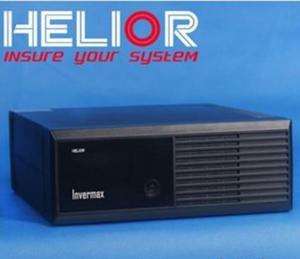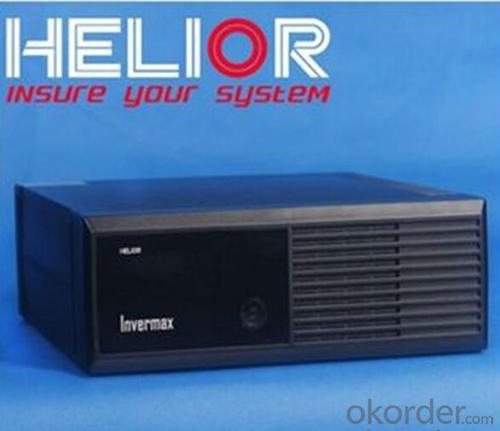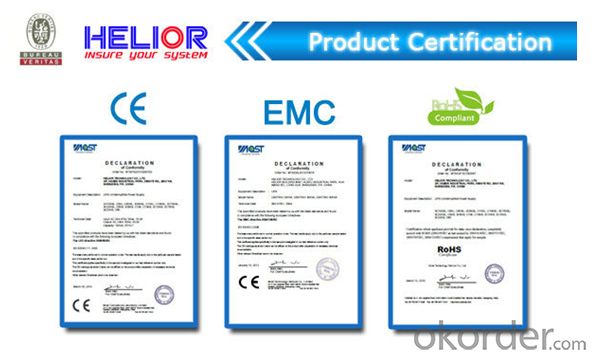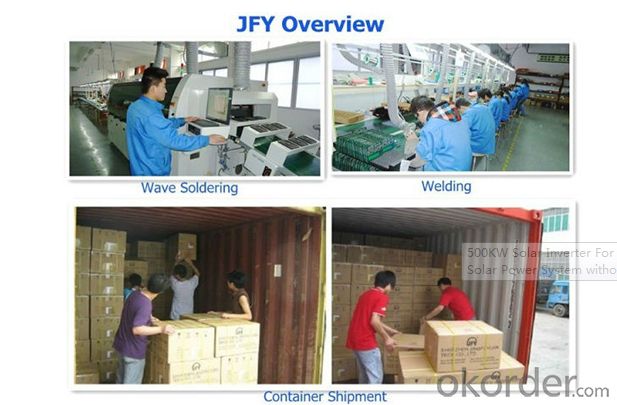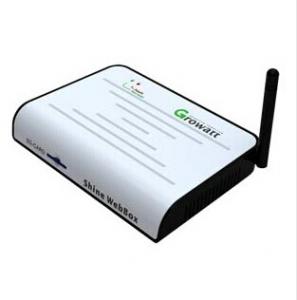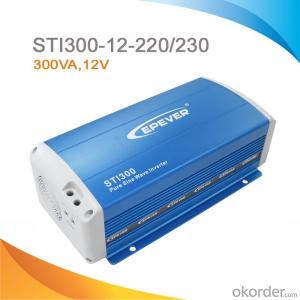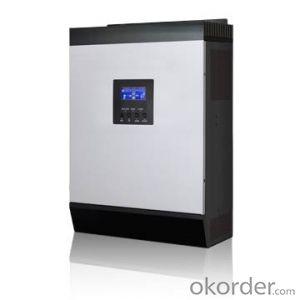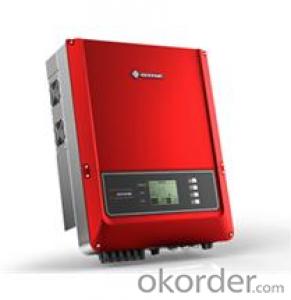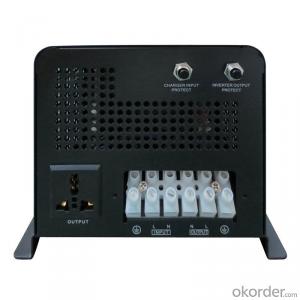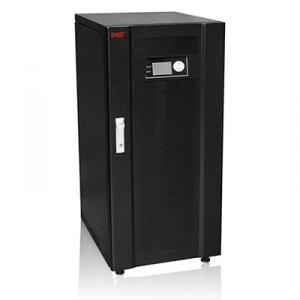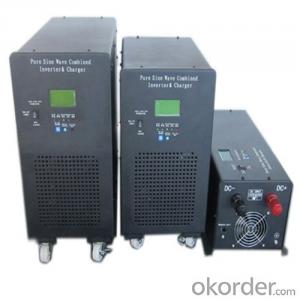Solar Inverter Suppliers - Best MPPT Inverter Hybrid A
- Loading Port:
- Shanghai
- Payment Terms:
- TT or LC
- Min Order Qty:
- 15 unit
- Supply Capability:
- 1000 unit/month
OKorder Service Pledge
OKorder Financial Service
You Might Also Like
1. Structure of Solar Inverter, Best Mppt Inverter Hybrid A Description
A solar inverter, or PV inverter, or Solar converter, converts the variable direct current (DC) output of a photovoltaic (PV) solar panel into a
utility frequency alternating current (AC) that can be fed into a commercial electrical grid or used by a local, off-grid electrical network. It is a
critical BOS–component in a photovoltaic system, allowing the use of ordinary AC-powered equipment. Solar inverters have special
functions adapted for use with photovoltaic arrays, including maximum power point tracking and anti-islanding protection.
2. Main Features of Solar Inverter, Best Mppt Inverter Hybrid A
• High Frequency inverter
• Rack Tower Design
• Off mode charging inverter
• Full automatic and silent operation
• User selectable for accepting wider input voltage
• Compact size for convenient use and storage
• Built-in 8Amp super charger for up to 100Ah battery
• Small Scale and cost effective inverter for home appliances and office equipment
• Two-steps intelligent charging control to reduce the recharging time
3. Power Inverter with Solar Inverter, Best Mppt Inverter Hybrid A Images
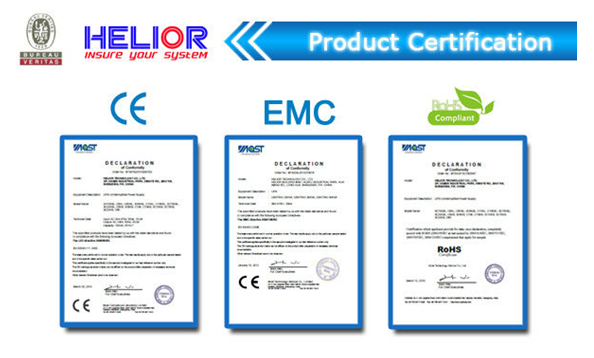
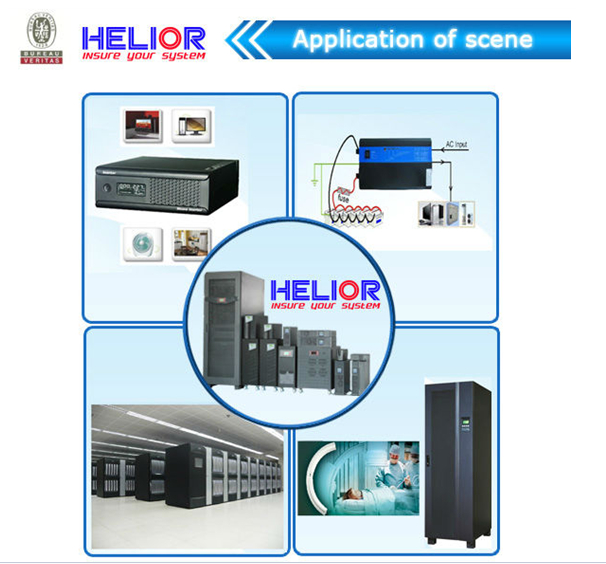
4. Solar Inverter, Best Mppt Inverter Hybrid A Specification
窗体顶端 MODEL窗体底端 |
| INVERMAX 500 | INVERMAX 1000 | INVERMAX 2000 |
CAPACITY | VA/W | 500VA / 300W | 1000VA / 600W | 2000VA / 1280W |
INPUT | Phase | Single | ||
Voltage | 110 / 120VAC or 220 / 230 / 240VAC | |||
Voltage Range | 90 - 145VAC or 170-280VAC ( Narrow Range ) | |||
50-145VAC / 90-280VAC (Wide Range) | ||||
OUTPUT | Phase | Single | ||
Voltage | 120VAC or 230VAC | |||
Voltage Regulation(Batt. Mode) | -0.555555556 | |||
Frequency | 50Hz or 60Hz | |||
Frequency Regulation (Batt. Mode) | +/- 0.1 Hz | |||
Output Waveform (Batt. Mode) | Modified Sinewave | |||
POWER FACTOR | P.F. | 0.6 | ||
BATTERY | Charger Current | 8 Amp + / - 1Amp | 6 Amp + / - 1Amp | 10 Amp + / - 1Amp |
Floating Voltage | 13.7V + / - 0.2V | 27.4V + / - 0.4V | ||
Overcharge Protection | 14.5V +/- 0.3V charger stops and fault | 29V +/- 0.6V charger stops and fault | ||
TRANSFER TIME | Typical | 8ms (Narrow mode) | ||
EFFICIENCY | AC to AC | >95% | ||
DC to AC | >80% | |||
INDICATOR | AC Mode | Green LED lighting | ||
Battery Mode | Yellow LED lighting | |||
Battery Charging Mode | Green LED flashing every 2 seconds | |||
Overload | Red LED flashing every 0.5 second | |||
Fault | Red LED lighting | |||
AUDIBLE ALARM | Low Battery at Battery Mode | Sounding every 2 seconds | ||
Overload | Sounding every 0.5 second | |||
Fault | Continuously sounding | |||
PROTECTION | Full Protection | Deep Discharge, Overcharge, Overload protection, Short Circuit, Battery Shot, Over Voltage and Under Voltage | ||
PHYSICAL | Dimension (DxWxH) mm | 224 X 255 X 80 | ||
Net Weight (kgs) | 1.7 for 500VA / 300W | 2.5 | ||
ENVIRONMENT | Operating Environment | 0~40 Degrees Centigrade, 0~90% relative humidity (non-condensing) | 0~50 Degrees Centigrade | |
Noise Level | Less than 45dB 窗体底端 | |||
5. FAQ of Solar Inverter, Best Mppt Inverter Hybrid A
Q1:Can we visit your factory?
A1:Sure,welcome at any time,seeing is believing.
Q2:Which payment terms can you accept?
A2:T/T,L/C,Moneygram,Paypal are available for us.
- Q: Can a solar inverter be used with a solar-powered irrigation system?
- Yes, a solar inverter can be used with a solar-powered irrigation system. The solar inverter is responsible for converting the direct current (DC) generated by the solar panels into alternating current (AC) that can be used to power the irrigation system. This allows the solar energy to be efficiently utilized for irrigation purposes.
- Q: Can a solar inverter be used with solar-powered streetlights?
- Yes, a solar inverter can be used with solar-powered streetlights. The solar inverter converts the direct current (DC) generated by the solar panels into alternating current (AC) that is required to power the streetlights. This enables the solar-powered streetlights to function efficiently and effectively.
- Q: What are the key factors affecting the warranty coverage of a solar inverter?
- The key factors affecting the warranty coverage of a solar inverter include the length of the warranty period, the reputation and reliability of the manufacturer, the quality of the components used in the inverter, any specified usage restrictions or limitations, and the level of technical support and after-sales service provided by the manufacturer.
- Q: What are the signs of a faulty solar inverter?
- Some signs of a faulty solar inverter include a complete loss of power generation, inconsistent or fluctuating power output, error messages or fault codes displayed on the inverter, unusual noises or excessive heat coming from the inverter, and a lack of communication or connection with monitoring systems.
- Q: How does a solar inverter handle reactive power compensation?
- A solar inverter handles reactive power compensation by using advanced control algorithms and capacitors. It actively measures the reactive power in the system and generates the necessary reactive power to balance it out. This helps stabilize the voltage and ensures efficient energy transfer between the solar panels and the grid.
- Q: Can a solar inverter be used with a solar-powered emergency lighting system?
- Yes, a solar inverter can be used with a solar-powered emergency lighting system. A solar inverter is responsible for converting the direct current (DC) produced by solar panels into alternating current (AC) that can be used to power electrical devices. In the case of a solar-powered emergency lighting system, the solar panels generate DC power, which is then converted into AC power by the inverter to illuminate the emergency lights. This setup ensures that the emergency lighting system can function even during power outages or in remote areas where grid electricity is not available.
- Q: Are there any disadvantages of using a solar inverter?
- Yes, there are some disadvantages of using a solar inverter. One major disadvantage is the initial cost of purchasing and installing the inverter, which can be relatively high. Additionally, solar inverters are susceptible to damage from power surges or lightning strikes, which can result in costly repairs. Furthermore, solar inverters require regular maintenance to ensure optimal performance, which can add to the overall cost. Lastly, solar inverters can produce a humming noise during operation, which may be a nuisance in certain environments.
- Q: What is the maximum AC output current that a solar inverter can provide?
- The maximum AC output current that a solar inverter can provide depends on the specific model and capacity of the inverter. In general, it is determined by factors such as the maximum power rating and efficiency of the inverter, as well as the size and configuration of the solar photovoltaic (PV) system it is connected to.
- Q: PV grid-connected inverter and independent inverter in the control of what is the difference
- And you said that the independent inverter, said off-grid inverter it, this inverter can not access the mains, the components of the electricity through the off-grid inverter to the battery charge, the battery at night
- Q: How does a solar inverter handle voltage and frequency regulation?
- A solar inverter handles voltage and frequency regulation by converting the direct current (DC) generated by solar panels into alternating current (AC) that matches the utility grid's voltage and frequency. It achieves voltage regulation by constantly monitoring the grid voltage and adjusting the inverter's power output accordingly. Frequency regulation is achieved by synchronizing the inverter's output frequency with the grid frequency, ensuring a stable and consistent power supply.
Send your message to us
Solar Inverter Suppliers - Best MPPT Inverter Hybrid A
- Loading Port:
- Shanghai
- Payment Terms:
- TT or LC
- Min Order Qty:
- 15 unit
- Supply Capability:
- 1000 unit/month
OKorder Service Pledge
OKorder Financial Service
Similar products
Hot products
Hot Searches
Related keywords
